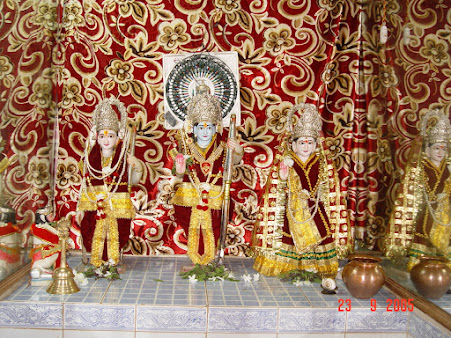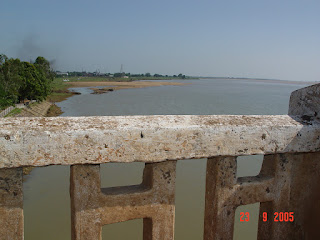In ancient times the pilgrimage to Puri Jagannath Temple in Odisha was not considered complete until devotees first paid their obeisance to Lord Rajiv Lochan, the principal deity at Rajim. The temple town of Rajim in Chhattisgarh, aka Panchkashi because of the presence of five Shiva Lingas – Fingeshwar, Kopeshwar, Kuleshwar, Pateshwar and Patneshwar – boasts the unique Rajiv Lochan temple dedicated to Vishnu. None other than the divine architect Vishwakarma himself supposedly built the temple and sculpted Vishnu’s idol. Unusually, pooja and archana at the temple are offered by the Kshatriya community, the descendants of Raja Ratnakar, ably assisted by Brahmin gurus!
Read on
Where Kshatriyas Perform Puja ----- The Unique Temple of Rajim
A jaunty ride through mud roads, about 50 km from Raipur, the State capital brings us to the temple town of Rajim. It is considered the holiest and one of the most ancient towns of Chattisgarh, situated on the confluence of the rivers Mahanadi, Pairi and Sondhul, thus earning it the sobriquet of the Prayag of Chhattisgarh. Mahanadi is considered in Chhattisgarh to be as sacrosanct as the Ganges; hence taking a dip in it and performing ceremonies on its banks are considered holy. In ancient times the pilgrimage to Puri Jagannath Temple in Odisha was not considered complete until devotees first paid their obeisance to Lord Vishnu as Rajiv Lochan, the principal deity at Rajim.
We walk down a flight of steps for the traditional cleansing of our feet in the sacred waters. I wonder whether it’s my fertile imagination that I see three distinct colours of the trio of rivers. I’m happy when my friends who accompany me on this jaunt, also observe the phenomenon without any promptings from me!
Rajim which is believed to stand on a lotus-shaped surface was referred to as Kamal Kshetra and Padampur in ancient times. It was also called Panchkashi because of the presence of five Shiva Lingas – Fingeshwar, Kopeshwar, Kuleshwar, Pateshwar and Patneshwar. However, the origins of its present name ‘Rajim’, is shrouded in myth and mystery. Legend has it that the town was named after Rajim Telin, a woman who sold oil. It is believed that Lord Vishnu who was immensely pleased with her devotion, promised to name the town after her.
Though the town boasts a plethora of temples that were chiefly built between the 8th and 14th centuries CE and dedicated to various deities, it is the 8th century brick temple of Rajiv Lochan dedicated to Vishnu that attracts devotees and tourists by hundreds of thousands. This is particularly so during Shivaratri and the Rajim Mahotsav.
The golden rays of the giant planet gently caress the temple dome as we enter its precincts. The monument belongs to the panchayatana style of temple construction and has four subsidiary shrines at the four corners of its courtyard which roughly measures 147 feet by 102 feet.
While the main and central shrine is dedicated to Rajiv-Lochan, meaning the blue lotus-eyed, the four smaller subsidiary shrines honour Narasimha, Badrinath, Vamana and Varaha.
The temple is built in close annexed style with elements of Dravidian architecture, as evidenced by its dome. Minarets, latticework, plain pillars and those sculpted with the pantheon of Hindu gods adorn various segments of the temple. A high point of the temple architecture that makes it stand out amongst several others in the region, is the blend of materials used in its construction. This has enabled the edifice to withstand the vagaries of weather. The bricks have been piled, cemented with a mixture of limestone, urad dal and the entrails of the bel fruit, making it sturdy.
The ornate doorway of the sanctum sanctorum of Rajiv Lochan is at once striking. Its lintel majestically holds Anantasayana, or Lord Vishnu in a reclining posture. Garuda, Nagas and amorous couples make up the rest of the temple art.
A sculpted figure of Trivikrama is particularly impressive and appears to be casually interspersed in one of the courtyard walls. The unusual feature of the figurine depicts Adisesha in the act of paying obeisance to the standing figure of Trivikrama whose right leg lifted high is shown crushing the ugly face of Brahmanda.
Tales abound on the origins of the temple and the deity of Vishnu therein. None other than the divine architect Vishwakarma himself supposedly built the temple and Vishnu’s idol. He sculpted the four-armed Lord Vishnu with consort Lakshmi on the right side and Yoga Maya on his left. Further, between a pair of arms he carved the episodic Gajendra Moksha with the elephant holding aloft the lotus flower and offering it to the Lord.
According to one legend, Lord Vishnu in the sanctum sanctorum was actually called Lochan and was once whisked away by Goddess Rajiv. The people of the village were so distraught at the disappearance of their favourite Lord and protector that they beseeched the Goddess to return the Lord’s idol. Appeased at the humble entreaties, Goddess Rajiv acquiesced on condition that her name would henceforth be associated with the Lord; hence the name Rajiv Lochan.
Yet others credit the construction of the temple to Jagat Pal a mythical king who is supposed to have erected the entire structure in a single day! Yes, those were days when one day lasted six months of our present time! As a tribute to the king, his idol resembling a sitting Buddha lies in one of the sanctums of the temple.
An apparently more plausible story is associated with the king Ratnakar and his steadfast devotion to Lord Vishnu. Pleased by the king’s bhakti, Vishnu appeared before him in the form of Rajivlochan and granted him a boon: that King Ratnakar would continue to see the Lord in this form for always and after him, his descendants would continue to serve the Lord in the temple premises. This is perhaps the reason why even to this day, the pooja and archana at the Rajivlochan temple are offered by the Kshatriya community, the descendants of Raja Ratnakar, ably assisted by Brahmin gurus!
Myths and legends apart, a rarity associated with the temple is the bare-foot idol of Vishnu crafted from black granite. Ritualistically, the deity is always draped in unstitched cloth that is never knotted at the ends but left folded. The pagri or turban adorning the Lord’s crown is woven by generations of a single family and the Lord is adorned thrice everyday in three different forms: as a child in the morning, a youth in the afternoon and as an old man in the evening!
On the occasion of Maha Shivratri every year, the Rajiv Lochan Kumbh Mela is celebrated in a grand fashion for thirteen days. Festivities begin at Triveni Sangam, the meeting point of the three rivers on magh purnima and culminate on the day of Shivratri. Besides several thousands of devotees who throng the riverside and the temple, at least a couple of thousand sadhus congregate at the venue to participate in religious activities and give discourses.
Factfile
Reaching:
Air: Raipur is the closest airport at 45 km from Rajim. Raipur is well connected to all major cities of India.
Rail: Raipur is the nearest railhead.
Road: Taxis ply between Raipur and Rajim and may also be hired privately.
Accommodation: Though PWD rest house is available, the more comfortable place of stay would be at one of Raipur’s several star and other budget hotels.














No comments:
Post a Comment